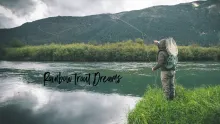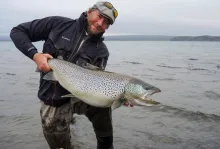The subtitle is "Competition-Inspired Strategies for Everyday Anglers", and that's exactly what you get
Updated or edited 9 months ago
Read the subtitle of the book carefully, because that is exactly what you get!
Devin Olsen is a competitive fisherman who was part of the US fly fishing team from the age of 21. He worked several years as a fisheries biologist, and he now owns a fly fishing shop. He is known as the author of “Tactical Fly Fishing”, a book in which he describes in his nymphing techniques, a practice that is gaining popularity on this side of the Atlantic while it has been well rooted in the practice of several European fishermen for decades.
With his acolytes Gilbert Rowley and Lance Egan, he also produced a series of three training videos on modern nymphing, which remain some of the best videos in the field for learning this method of fishing. Devin Olsen is certainly a tactical fly fisherman, but also a good pedagogue, and he uses this strength in this new book.
Devin tackles fly fishing in lakes and reservoirs with the same approach that sets him apart in his other achievements; the application of methodical fly fishing competition strategies adapted for the average fisherman.
The first three chapters gather the information that any good lake fisherman must know:
- productivity and temperature
- the distribution of food sources
- ecology of lakes adapted to fishing
Yes, I hear your question "isn’t this a little too academic for the fisherman?
My answer is "No".
The serious fisherman as well as the average fisherman will find lots of useful knowledge in the chapters on strategies, methods and techniques.
Devin's degree in fisheries science is highlighted in these three chapters while the content is presented in a way that could be an advanced course in lake biology at college, adapted for fly fishing.
In short, it is clear, well written, easy to read and understand if you are one of those who like to learn.
The next chapter is about gear. There is nothing different about fly rods for lake fishing that Phil Rowley and Brian Chan's books on the same subject hasn’t already taught us.
Devin limits himself to suggesting a few brands of fishing rods that meet his criteria. As soon as the fisherman has understood these criteria, he will be able to choose from a multitude of brands available on the market. There’s no need to drag on here and the author knows it well.
For reels, it is different, as he suggests to using cassette reels such as the Hardy Ultradisc, a judicious and relatively economical choice when you want to have lines for all fishing situations in lakes and reservoirs. Experts like Devin own up to 15-20 different fly lines. That said, the average flyfisher will do very well with 3-5 lines.
Fly lines from two major brands are seriously analyzed, even going so far as to carry out tests in a pool with the help of a diving friend… a very helpful section.
It is always with the same rigor that he addresses the questions of choice and preparation of equipment for a day of fishing, the approach and tactics.
Standing on the bank of a lake or reservoir that he does not know or or only knows a little, the fisherman may feel lost and not know where to start. Devin covers how to approach a new body of water.
In a very orderly way – as a fisherman would do during an international competition – he describes how he searches for fish using the morphology of the water and the natural elements he observes: inlets and outlets, beds of aquatic plants, rocks and borders, etc.
His ideas are well structured and facilitates the understanding of what he writes without it becoming too tedious and technical... just the right dose to acquire new knowledge and not too much to make everything indigestible.
Just the right dose to acquire new knowledge
and not too much to make everything indigestible.
Then follows a complete chapter on boat fishing and how to use wind drift to properly survey the body of water, a method inspired by British techniques and which he calls the loch-style. This chapter is particularly informative and different from what I have read in other books. The use of aerial photos and the annotations added do an excellent job to illustrate his words.
The following short chapter on fishing from the shore is well adapted to regions where water bodies are cleared on the shores, less well in regions like mine where it is rarely possible to access the water from the shore because the forest is so close and dense.
Chapter 8 is titled "Case Studies". It made me plunge back 40 years while I was studying natural sciences. I appreciated the 7 fishing situations he presents because they make it possible to clearly understand the specific applications of the suggestions he makes in the previous chapters. Each of the cases is presented in the same way starting from a location, weather conditions and ways of approaching the fishing day according to the factors to be considered, all analyzed carefully.
Finally, the last chapter suggests a few flies that are effective in most regions of North America and elsewhere for fishing in lakes and reservoirs.
Devin Olsen worked on the content of this book in a systematic and methodical way. If this suits you, if you are a serious lake fisherman or want to become one, you will like this 230-page book illustrated with quality photos.
Professor Olsen is an accomplished pedagogue who writes what is important and does not waste time with the superfluous. The content is well structured and presented with the level of detail necessary for fishermen, no more, no less.
- Log in to post comments







